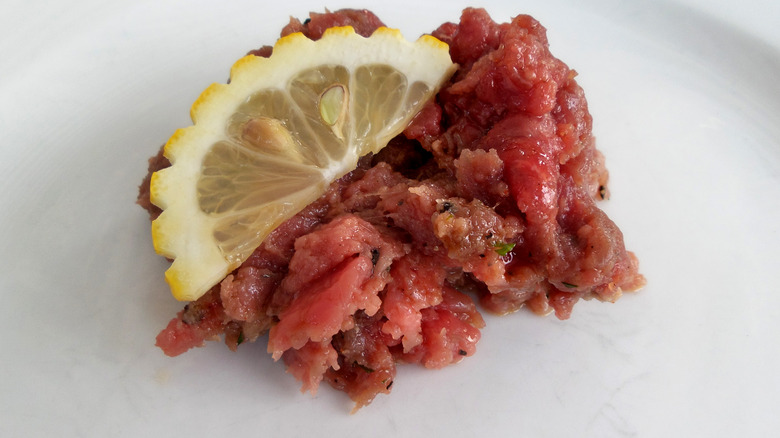The Cut Of Beef Dario Cecchini Says You Should Prioritize For Steak Tartare - Exclusive
Tartare is a dish that elicits many opinions. It's often regarded as a luxury or delicacy plate, and, as it is served raw, it leaves many to wonder how — or why — it is safe to eat. In terms of nomenclature, meat-minded cooks mostly agree that there isn't a huge difference between calling it beef or steak tartare; even the history of tartare is up for debate. The longer you speak to those who enjoy the dish, the more diverse beliefs about it arise, including what cut you should ideally be using to make beef tartare.
Recently, Tasting Table sat down for an exclusive interview with legendary Italian butcher Dario Cecchini. Along with cutting and cooking a slew of other carnivorous dishes, Cecchini's hands are skilled at making tartare, and we wanted to know what tips the chef has for those also looking to make the dish. Along with a list of essential ingredients that you should mix in — including minced garlic, parsley, lemon, and an abundance of olive oil — Cecchini gave us a clear tip on the particular type of cut he recommends for beef tartare. According to Cecchini, "What you would want to look for is a nice lean piece of meat that absolutely should not be filet. What you really want is a lean cut that can even be quite tough."
Why you should use a lean cut
When it comes to sourcing meat for any dish, there are clear trade-offs to consider. Fattier, more naturally tender cuts are full of flavor but come at a higher cost; tougher cuts are less delicate but lighter on the wallet. Per Dario Cecchini, cheaper cuts don't mean less flavor. "Because a lean, tough cut is going to be one of the muscles that work hard on the animal, like cuts from the legs, carrying the animals, they're going to be full of flavor."
Tough steaks, such as chuck, skirt, or flank, can be just as appetizing as premium cuts — NY strip, ribeye, tenderloin filet — but they require cooks to work more to reach that flavor. That's why leaner, tougher cuts are chosen for long, slow cooking methods that soften the muscle: typically braising, marinating, and dry brining.
Raw chopping for tartare, however, offers an overlooked shortcut for some tougher cuts, like top sirloin. So long as you avoid inedible pieces of gristle or uncooked fat, a lean cut like top sirloin filet can lead to delicious tartare at a more accessible price.
Following the rules of natural tenderness, many food professionals gainsay Dario Cecchini's advice and opt for finer cuts to make tartare. And why not? If you have the money, the filet is an easy and flavorful choice. However, as one of the world's preeminent nose-to-tail butchers, Cecchini's recommendation naturally counters industrialized butchery by encouraging cooks to think beyond highly marketed subprimals.

